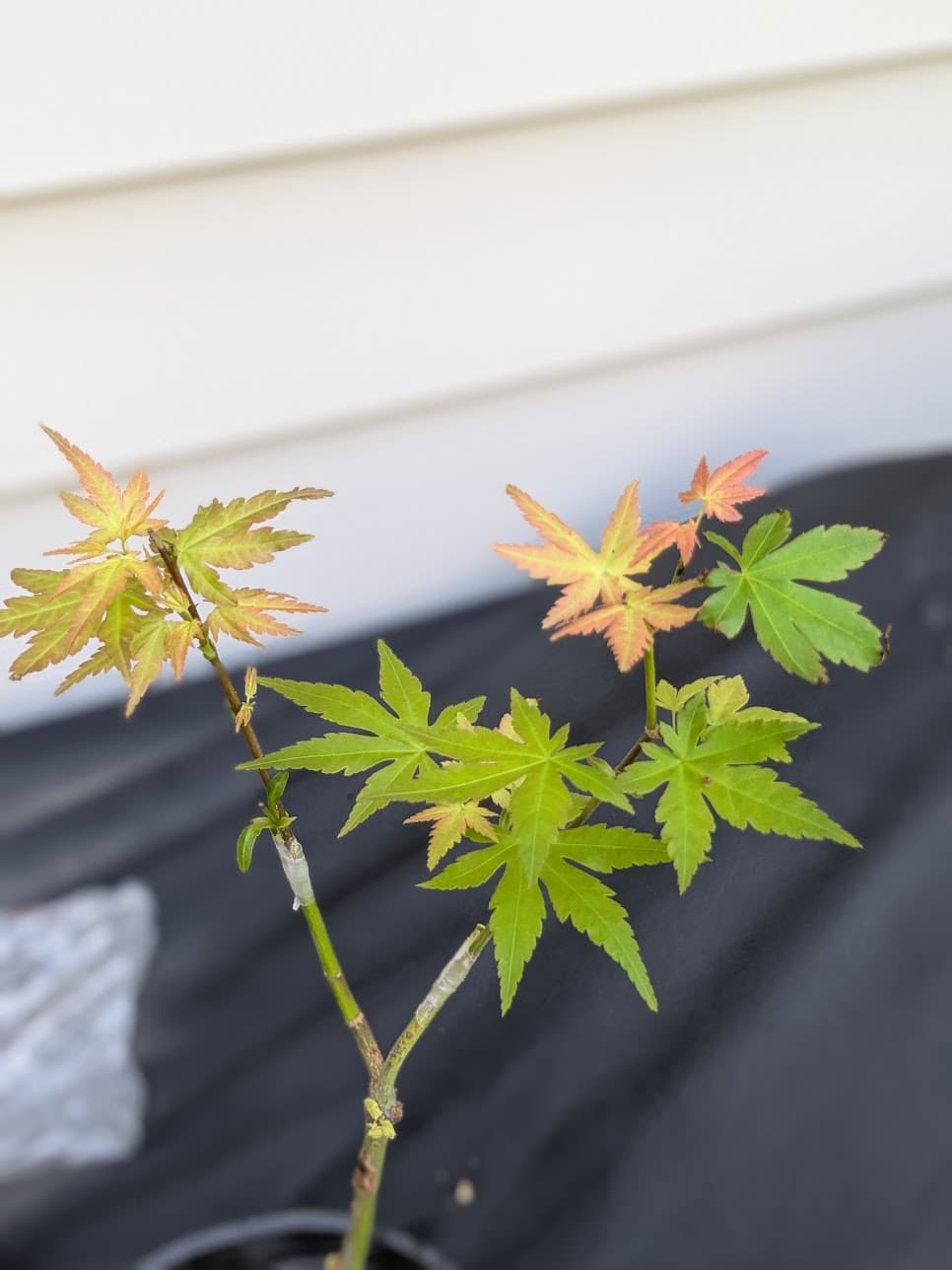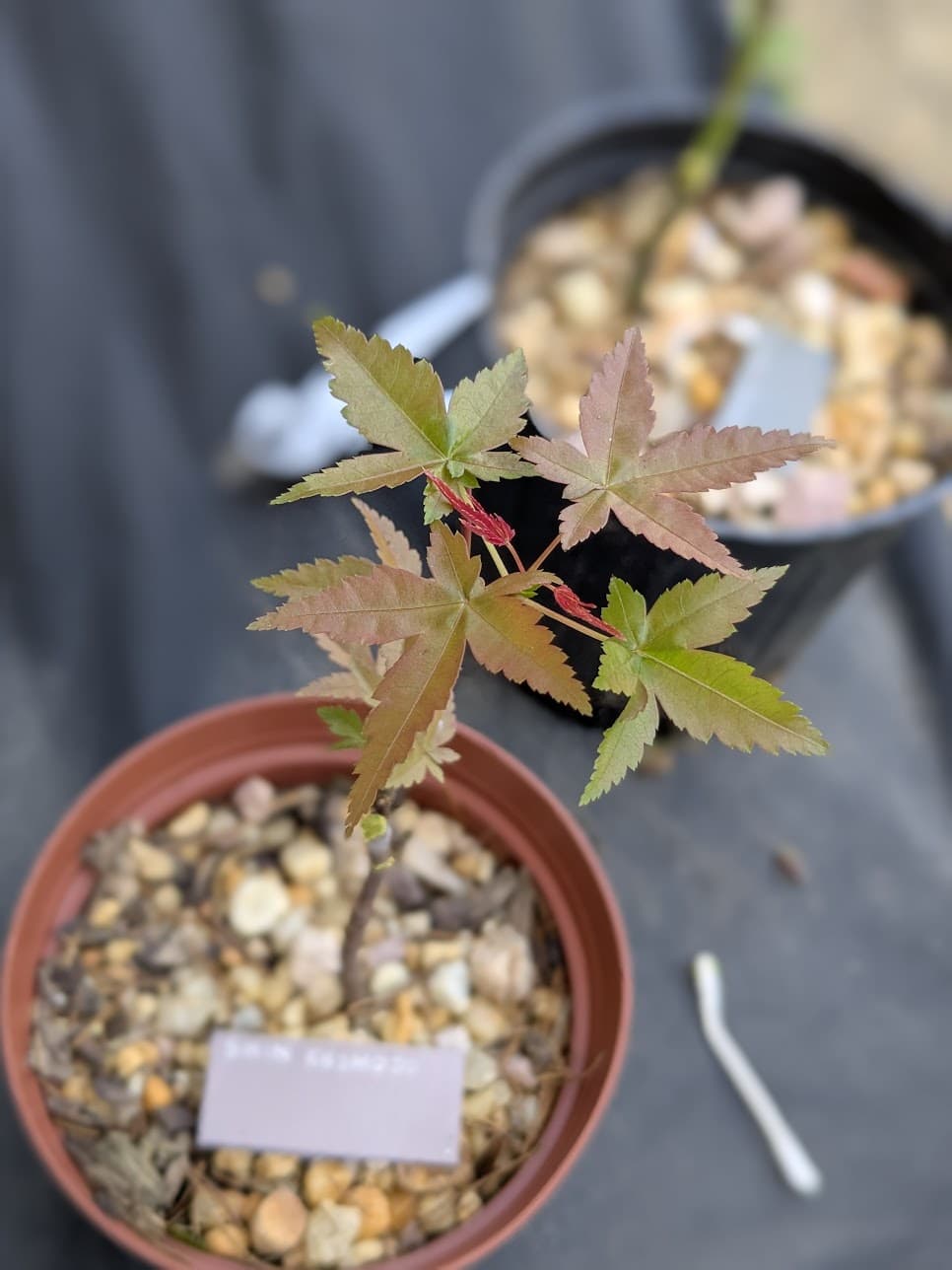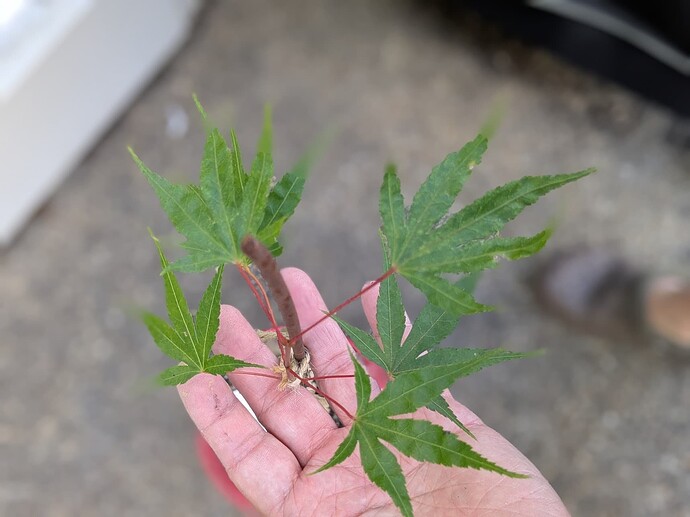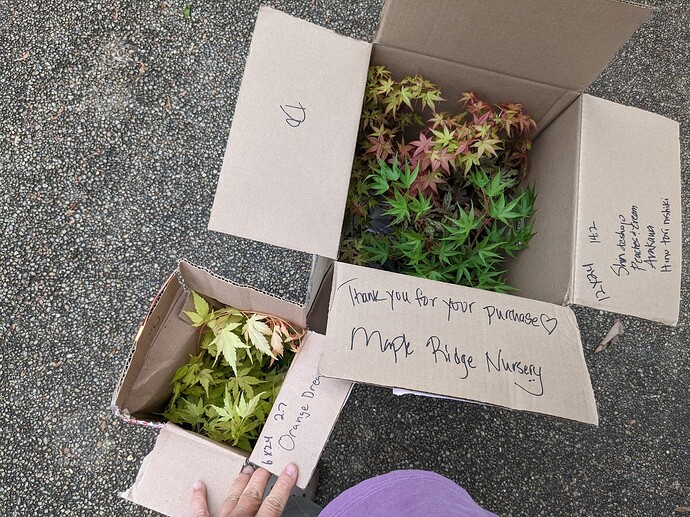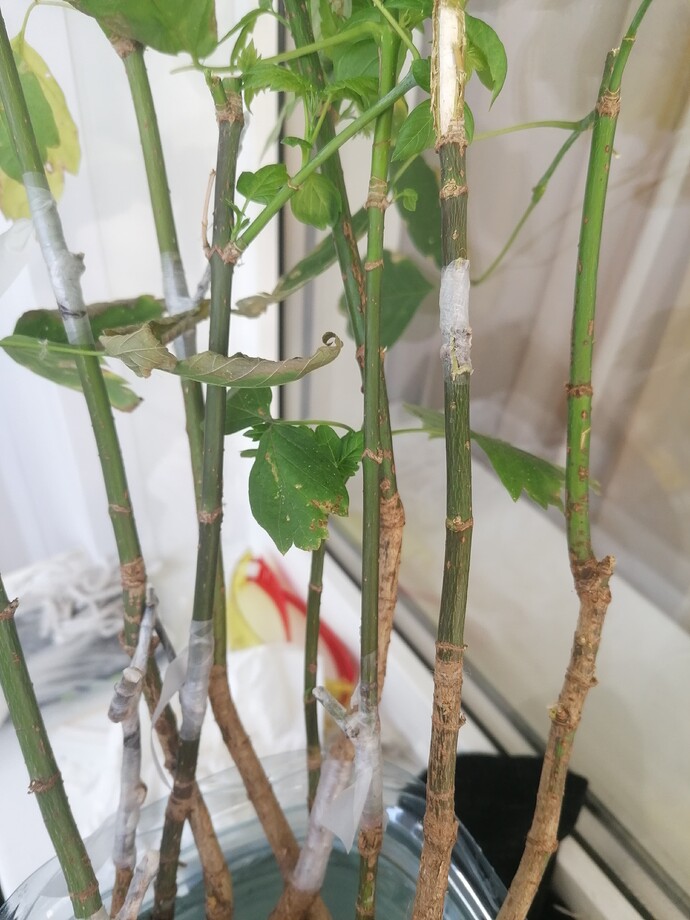The Acers Japonica and such are another love of mine. I am wondering if anyone here also grafts them. I don’t graft them yet but wondering if there is much difference than with fruit. I read up a bit and they discussed veneer grafts. I have started seeds before with luck.
I used to graft them in the summer. You can put any of these onto the others: palmatum/japonicum/shirasawanum/sieboldianum/pseudosieboldianum/circinatum
Grafting Japanese maples in the summer is the greatest. You can start grafting the end of July. Optimum time is mid-August (two weeks) till September 1 for grafting more maples. The maples make up in about 10 days and you put them out in a shade house and they will break the following spring. Works great.
First prepare the understock. Trim a few of the lower branches and some of the leaves. Next prepare the scion. Cut all the leaves from the scions leaving the little stems on (petioles). Don’t graft on understocks that are soaking wet as it will cause the union to bleed and you will have poor luck. I like them a little on the dry side. Next veneer graft them.
After you have grafted them you must put them in a humid environment but not in sun. If you have a greenhouse or a hoophouse, put white poly over your prop house and tent the grafts inside. That will keep the grafts cooler than clear plastic. After 14 days you will see the stems of the leaves that you cut off begin to fall off. Once you see that it means the grafts have taken.
You can make some wire hoops for over the grafts and place light plastic over the grafts to give that humid environment. Try to keep the plastic from touching the maples as this may cause fungus problems. You must put a shade cover on your prop house also. This is important.
After 14 days you can put them outside in light shade and treat them like they were normal plants. Leave the understock on until spring. Keep your maples a little on the dry side after you graft. Only enough to keep them alive for the first 14 days Then you can water the heck out of them.
If you don’t have a prop house, you can use a camping tent. No bottom heat, no wax is needed; the humidity takes the place of that. The petiole will fall off when the graft takes, not fails. It is the new bud growing under the petiole that makes it fall off. If the graft fails the new bud will not grow.
It is so easy. If you use a tent you can put it in a barn or similar (under a large shade tree with all dappled light/a few hours of morning sun and then shade all day); a garage facing north; The tent up against the north wall of a tall structure; I suppose a nearing frame would work very well too if you tent. All you really have to have is light and humidity for those 14 days. In 14 days you will see full callous.
Dax
Thanks Dax! You have been most helpful, going above and beyond. I owe you one. Circinatum are native here so finding seeds should be easy. I am excited and hopeful.
Carole
What are you using for understock?
DG
You’re welcome. It’s the same for Ginkgo. Both are great summer-grafters.
I used palmatum DG.
Dax
I’m going to rejuvenate here as it’s an existing thread on a sideline question I am exploring. (i.e. not really fruit related but in line with the smarts of many of you.
I bought the house I’m in several years ago and have found that whoever did the landscaping proximate the house did not have a firm grasp of the adult size of things. I love many of their choices, but not their placements. One of these is a Japanese maple that is too close to both the house and the driveway, with the primary access sidewalk really cramped in the process. I’ve only gotten so far with shaping it. So my question…
Can I graft Japanese maple onto root material?
In this case, I would love to take scion from the tree and graft onto it’s own roots in a better location so I preserve the combination I’ve got. It’d be close enough to benefit from it’s own fines and ideally be able to coopt a significant portion of its former root-base when I eventually remove the original tree.
Do Japanese maple work this way? If no, can I induce it to send up it’s own sucker at a distance from the tree that might make suitable rootstock in a year or two?
The current extent of its dripline covers an ideal zone for the tree to have originally been planted, but it is far too large for me to undertake actually moving it en masse.
Honesty… you are way over-thinking a non-complicated procedure of buying a Japanese maple at a Big Box Store for what 35-45$ with a big old root system already and using that to graft another tree. It’ll be a 2-gallon or 3-gallon or 5-gallon tree. Done, hands washed.
Or find a gallon little Japanese maple for 15 or 20 bucks to match caliper of graftwood.
Thank You, but…
They’re not quite so cheap around here, and I don’t know what the original rootstock is. I like the size and shape of this combination. It’s not so much an overthinking as a desire to coopt at least part of the established root system. I don’t know what to expect from a new tree or combination, but I know what to expect from this one. What you are suggesting is the solid second choice, but it’s not significantly higher than just removing the tree and offers no sense of “saving” the tree.
Thus the question, can what I actually want to do be done? It’s okay if it can’t and it’s okay if we don’t collectively know Although samaras are often edible, it’s not exactly something one grows for that purpose.
Well, I dug up two overgrown holly roots next to the house and found that the maple had sent roots under the sidewalk. I’ve set up two green grafts on the roots to try it out. If it works, I’ll explore n the dirt about the same distance from the trunk in a more desireable direction.
With the hollies gone, it won’t be as crowded and in the way, but it would still be nice if I could bewitch it about 6 - 10 feet further into the yard. Or shrink it back to half its current dimensions.
I tried grafting Japanese maples last year and failed miserably, got 1 out of about 3 dozens to take. I did only about a dozen this year and got 3 to take. Orange Dream and Shin Deshojo were done using veneer grafts and the Arakawa was done with an approached graft.
Good job with the ones they took! Question where did you find scions? Thanks
Well it’s something!
What’s the rootstock you’re using?
I’m trying the nearly invincible Box Elder.
Only a few weeks in, but it’s going well!
I got mine from a summer garden in the middle of the street here in Moscow and the first time from my sister’s (New York State) Japanese maple, that was getting so tall it was rubbing the roof. I used that hoping that it was a different variety from my parents and after growing they will pollinate each other.
My experiment is posted just above.
I bought five 1-gal pots of different varieties last year and harvested cuttings from them this year. They’re kinda expensive so I just wanted to propagate some for friends and family, and also as pre-bonsai materials.
The rootstocks were grown from seeds collected from a local park. They are just the generic red/green varieties.
That’s awesome! I wanted to do something like this but I didn’t know where to get Japanese maple scions from. Last year I went to dig out o lots of little Japanese maple saplings from a ditch where a nursery used to be but they closed down but they left lots of trees planted in the ground that now are really tall and every year they drop all the seeds and lots of saplings keep coming up so I just go and collect the ones growing in the ditch otherwise they will be cut down when state workers cut the grass alongside of the roads.
Generic red green maples? Or Japanese Maples? So Japanese maples on Japanese maple seedlings, right?
(Second to the right is doing best) This is a chip bud on a box elder seedling I pulled out, I’m treating it very badly but the chip bud is healed and calloused, but even though I cut it off it doesn’t want to push growth out of that bud this year… It seems.
Sorry I wasn’t clear, when I say generic green/red maples I mean standard acer palmatum seedlings and not named cultivars.
Same with me, the trees at the local parks produces many seedlings every year that gets cleared and mulched over by park employees. I pull a couple of handful each years in addition to the ones I start from seeds collected from those same trees.
I always try to graft fresh scions within minutes/hours of collecting JM cuttings, I’m not sure how they would work if we collect them like fruit tree scions in Jan/Feb and graft them in April/May. I find JM grafts very finicky and very susceptible to drying and/or fungus.
I think freshly cut scions are the way to go, last year I try grafting some JM from scions that I collected the year before in the fall and keep them in ziplock bags in the fridge and some others I put them wrapped up with cling wrap and also add a moist paper towel but when I got the out of the fridge most of them were dry and a couple they even look they had like mold. So they didn’t work for me like that, that’s why I think freshly cut scions is the way to go.
I think I have some good tips for you and @Ruben
My best success with collecting scions is just before the buds start swelling, but that’s risky, so whenever you’re getting worried that spring might start is a good time to collect them.
Paper towels grow mold like crazy, so the best is to put them with cedar sawdust or the most fragrant sawdust on hand, pure pear is also okay, bag them moisten them, then wrap them with cellophane tightly and refrigerate them.
Also with grafting syrup producing maples like Norway maple, I read that the best success is in summer and the early sap flow can drown scions. I expect if it’s already warm in spring you’re past the danger, but you could graft so that you cut off the rest of the tree after the graft healing is already finished.
And what kinds of summer grafts do you do? Patch grafting, bud grafting, T buding?
